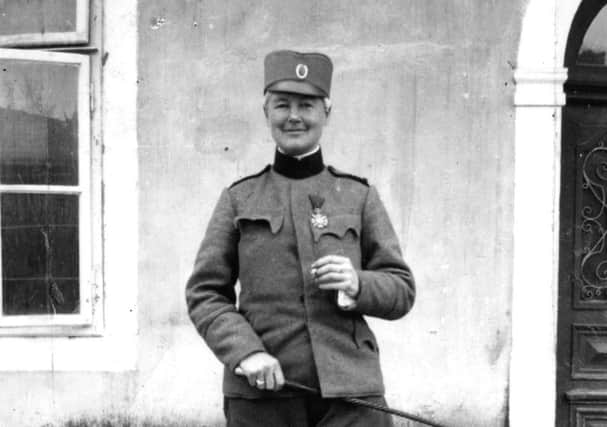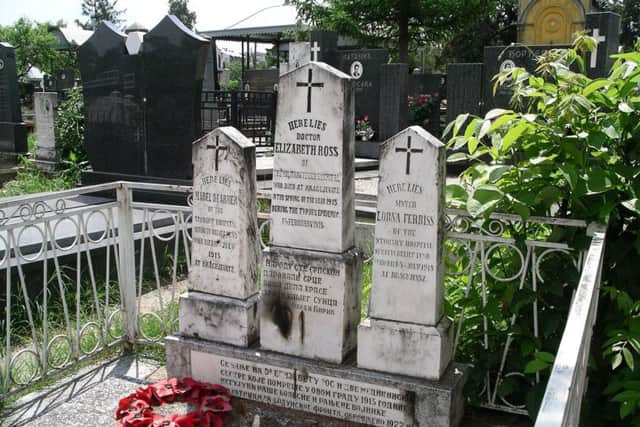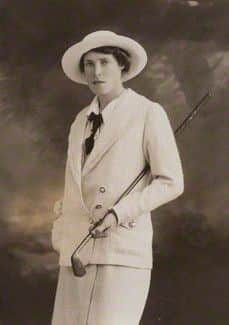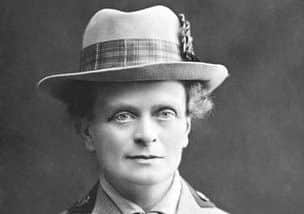Scottish heroines of the First World War in Serbia


These women remain heroines to the Serbs, who still honour their work among them.
The graves of these women lie scattered across Serbia: in the Commonwealth War Graves Cemetery in Niš, in the industrial city of Kragujevac, in mountainous Bajina Bašta, on a remote hillside outside of Raška, in Predejane in the south.
Advertisement
Hide AdAdvertisement
Hide AdBut their work is poorly commemorated in Britain, the country of their birth, which is why a new public exhibition at the Scottish Parliament: John Bellany and the Scottish Women’s Hospitals is so welcome.


Friendship
The shared history of these women and the Serbs during the First World War formed the basis of strong bonds of friendship between Scotland and Serbia which deserve to be better remembered.
They were formed by the work of women like thirty-year-old Mary Mackenzie from Lochinver, who journeyed to Serbia with the Scottish Women’s Hospitals in March 1915. Most, like her, felt they were off on a great adventure, while getting a chance to serve the Allied war effort like their fathers and brothers.
“Well, it was a wonderful adventure,” recalled one of them years later, “but not in the sense which we had imagined.” With the rare exception of a few battle-hardened nurses who had treated British soldiers during the Boer War, most had had the same sort of experience as Mary, of working only in the tidy, hygienic and highly disciplined wards of British hospitals.


Nothing could have prepared Mary for the conditions she was about to face.
She had travelled with a small group of women to reinforce the First Serbian Unit of the Serbian Women’s Hospitals, who had arrived in Serbia in early 1915, at the outset of a typhus epidemic that would claim upwards of 150,000 lives across the length and breadth of Serbia before it petered out later that year.
One member of her group commented dryly to the Scotsman that, when the British Consul saw them off from Salonika (now Thessaloniki in Greece) before their journey north into Serbia, he gushed emotionally that they were “noble women and heroines” and that “almost certainly they would contract typhus and return no more”. (“An Epic Retreat”, 14 January 1943, pg. 4) After they finally reached their destination of Kragujevac, a town about sixty-miles south of Belgrade, they found their colleagues exhausted and depressed, having attended the funeral of one of their own nurses that day.
Advertisement
Hide AdAdvertisement
Hide AdAnother had died two days before and a Scottish woman doctor a fortnight previously.


Mass graves
The deep shock of seeing sights for the first time that could have come straight out of the Black Death never left them, of hospitals, hotels and public buildings filled with dead and dying men and of ox-drawn wagons hauling carts of bodies to the cemetery where they were stacked like wood awaiting burial in mass graves.
They began work, doing what they could. “Mattresses were stinking and filthy with body fluids and infested with bugs and lice and had to be burnt”, remembered Mary. “Temporary beds were made with straw and hay. Hygiene had to be established.


Staff knew that if they caught typhus they would probably die so they wore trousers tucked into boots that were oiled to prevent the lice climbing up them, gowns with the sleeves tucked into rubber gloves and then their arms were bandaged with bandages soaked in carbolic. The conditions were foul. “We needed our masks!” Before the end of the war, twenty-one British women would lose their lives as a result of their work for the Serbs, mostly from disease. Mary survived.
Britain had promised military support to Serbia early in the war but, caught up in exigencies elsewhere in this global conflict, it was too slow to arrive to save the Serbs from eventual defeat in late 1915. But the women, like Mary, who arrived in their hundreds to treat sick and wounded Serbian soldiers in 1914 and 1915 provided the Serbs with tangible proof of at least the moral support of the British people.
The stories that filled British papers outlining the suffering of the Serbs during the Austro-Hungarian invasions of 1914 and the typhus epidemic of 1915 were met by a wave of sympathy in Britain. But the origins of the improbable friendship that arose between British women, many of them strong suffrage supporters, and the men of the Serbian army lay instead in the refusal of the British War Office to accept the offers of help from British women doctors at the outset of the war.
Elsie Inglis
The most famous case was that of the Edinburgh-based suffragist doctor, fifty-year-old Dr Elsie Inglis who, upon offering her services to the War Office at Edinburgh Castle, was famously rebuffed with the words “My good lady, go home and sit still”.
Advertisement
Hide AdAdvertisement
Hide AdThis off-hand dismissal, of a competent and experienced doctor, was the catalyst for what Dr Inglis then did: she came up with the idea of what became the Scottish Women’s Hospitals – hospitals entirely staffed by women, from surgeons, doctors, nurses, x-ray technicians to stretcher-bearers, orderlies and drivers.


After funds started pouring in from across Britain to support her scheme, she offered hospitals units to Serbia and France in 1914, both accepted with alacrity. By the end of the War the Scottish Women’s Hospitals had sent fourteen units to several war zones and raised nearly £450,000, the equivalent of millions today.
Four of the fourteen units were based in France. The other ten worked with the Serbs who, facing military collapse and epidemics, were desperate for any competent help they could get, regardless of age, sex or background.
In exchange for their help, the Serbs gave these largely women volunteers the freedom to work as they wished, just like their male counterparts.
This equality, virtually unheard of anywhere in the west, meant that women were given roles commensurate with their abilities. Women doctors and surgeons were permitted to work unhindered near the front line and women drivers were allowed to undertake some of the most dangerous driving of the war. This freedom also allowed one English woman, Flora Sandes from Suffolk, to fight throughout the First World War as an enlisted soldier in the Serbian Army.
Women were also given freedom to risk their lives in their work. Of the twenty-one British women who died as a result of their work for the Serbs during the war, eight were Scottish: nurses Louisa Jordan, Agnes Earl, Caroline Toughill, Violet Fraser, doctors Sybil Lewis and Dr Elizabeth Ross, driver Margaret Neill Fraser, and orderly Olive Smith. Dr Elsie Inglis also did not survive the war, dying of cancer in Newcastle the day after she saw the women of her Russian unit safely to British shores in November, 1917.
Tribute
The latest tribute to the work of these women by the Serbs is a series of six stamps “British Heroines of the First World War in Serbia”, released in December. The links forged with Serbia by the work of these women also have a physical presence in the numerous plaques placed in their honour and in the naming of streets and buildings after many of them.
Advertisement
Hide AdAdvertisement
Hide AdBut links were formed during the war with Serbia here at home too when, under the auspices of the Serbian Relief Fund, nearly four hundred Serbian children were given refuge in Britain. They were sent to fourteen Serbian “colonies” across England, Wales and Scotland.
One such colony was established in Edinburgh, when the Governors of George Heriot’s School generously agreed to give free education to twenty-seven of these boys.
All had survived the horrors of the “retreat”: a journey over the mountains of Albania and Montenegro during the winter of 1915-1916 to escape capture after their country suffered catastrophic defeat at the hands of Germany and its allies. The first ten arrived just before the start of the new school term in August 1916.
Almost without a word of English between them, they were embraced by the School and supported by the generosity of the people of Edinburgh during the war years until they were able to return to what remained of their homes.
Over the three years they were hosted at the School, several shone academically.
But it was on the playing fields of Goldenacre where they gained fame. These boys, who had never played rugby before, embraced the game and showed extraordinary and unexpected talent.
Several were good enough to join the First Fifteen, where they played alongside future Scottish internationalists like Daniel Drysdale. They are further credited with having played the first Serbian international rugby match on the fields of Inverleith in 1918 and for having brought the game back to Serbia following their return.
Legacy
Advertisement
Hide AdAdvertisement
Hide AdAfter the war, all returned to what became Yugoslavia. Equipped with their education and fluency in English, many were involved in the rebuilding of their country following years of enemy occupation. Among their numbers were engineers and teachers. There was also an economist, bank manager, army officer and a doctor. They left a lasting legacy: one wrote the first atlas of the world for Serbian schools, while three of the engineers were involved in post-war projects that changed the cityscape of Belgrade, like the building of New Belgrade and the Church of St. Sava.
Many of the boys kept in touch with George Heriot’s School for the rest of their lives. “The prime of our lives was spent here in this beautiful country with your grandfathers and grandmothers,” wrote one of them when he was in his eighties. “We can never forget the hospitality and friendship which we felt everywhere in Scotland. At that war time we were homeless and parentless so our gratitude to Scotland and Scottish people will last till the end of our lives.”
The last surviving Serbian Herioter, Dimitrije Dulkanović, died in 1995, aged 95. He was buried in 1995 in Zemun, Belgrade, in his Heriot’s school tie.
In June, 2016, George Heriot’s School is set to welcome around twenty descendants of these boys, most of whom will be seeing for the first time the School and the city that changed their fathers’, grandfathers’ and great-uncles’ lives.
The public will have a chance to hear them speak about the experiences of their fathers, grandfathers and great-uncles at the School and in Edinburgh, in a public talk at the National Library of Scotland on Monday, June 6th. Meanwhile, the exhibition at the Scottish Parliament is set to run until 16 April.
Historian Louise Miller will deliver a talk on the subject of Flora Sandes at the Scottish Parliament on 6 February.
